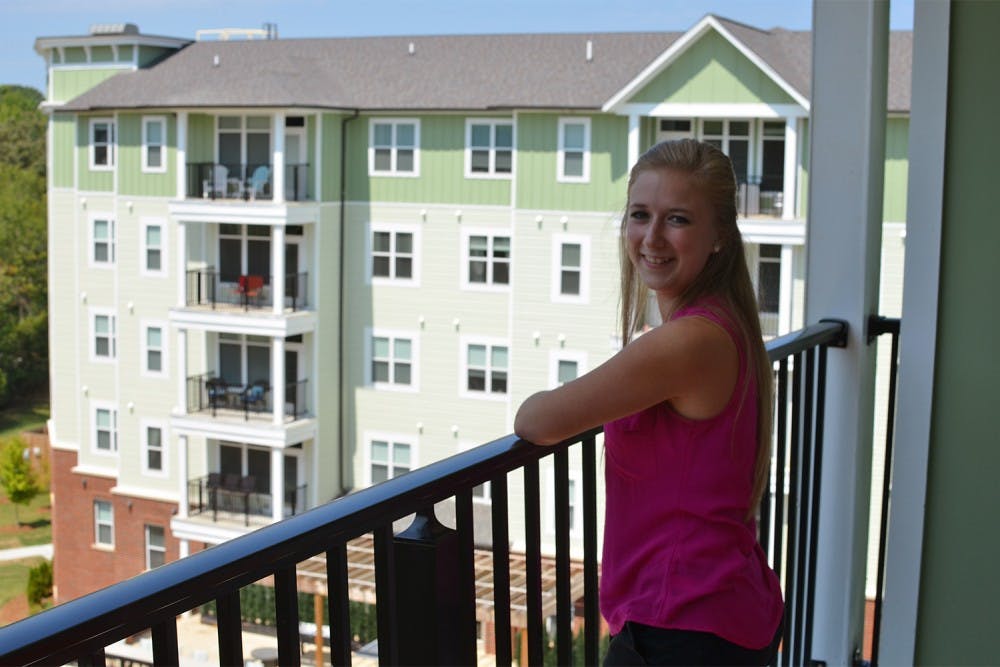While Sanderford said she does miss her old suitemates and midnight trips to Rams Head Dining Hall, she loves the amenities, the independence and the convenience of living in LUX.
“You get the community atmosphere that you get in a dorm because it is mostly undergrads, but you also get the privacy aspect if you want to go sit in your room and close your door,” she said.
“The closer dorms on campus are some of the older dorms, so if you want to be close to campus, you have to give up some of those amenities.”
Problem on campus
The decrease in on-campus housing enrollment has led to the repurposing of two residence halls on campus — Stacy and Everett.
“The closings were heavily influenced by the new apartment complexes off campus,” said Rick Bradley, the associate director of housing and residential education.
Taylor Bates, the president of the Residence Hall Association, said the rise in students living off campus is becoming a problem for the dorms, but it also gives his organization and the University an opportunity to grow.
“We have to take a chance to adapt and realize that housing has changed since the dorms were built,” Bates said. “If we update our approach, we can survive all of the off-campus apartments that our being built.”
A previous method to attract students to on-campus housing was a plan to build a new apartment-style dorm on Ridge Road filled with super-suite-style rooms.
The proposed dorm would have been located near Ram’s Head park deck and built by 2017. However, the plans were postponed due to an increase in cost and the declining trend of on-campus living.
Bradley said he had no doubt that the new building would have been filled had it opened. However, he said it would not have solved the problem of filling other dorms.
“We have to improve the quality of buildings that receive less demand,” he said.
To get the day's news and headlines in your inbox each morning, sign up for our email newsletters.
In the fall, Bradley said that a new plan to improve housing would be put in place by the new director of housing, Allan Blattner.
“Our department will be involved in implementing a strategic plan to make improvements,” Bradley said.
The strategic plan includes polishing old policies, solving facility issues and creating programs for upper classmen tied to their majors in order to make on-campus living more attractive. Bradley said he does not think the plan would increase student rent, as the cost for the plan would come from fund-balanced money.
Bates said there could be many simple upgrades to improve dorm life. These upgrades include simple changes like more modern ice machines, more hooks in the bathrooms and painting the walls a color other than cream.
Bradley said there are still valuable reasons that students choose to live on campus.
“There is a greater connection to the culture of the institution,” he said.
Community problems
With the increased desire for off-campus living, most students look for affordable housing. However, this displaces Chapel Hill residents that also need affordable housing, such as those who are now being pushed out of the historically minority community of Northside.
To help slow Northside neighborhood’s rent increase from the onslaught of student renters, UNC provided the town and the Jackson Center with a $3 million no-interest loan.
In Carrboro, Bethany Chaney, a member of the Board of Aldermen, said more than 60 percent of the housing stock is rental properties. She said it is assumed that those properties are geared toward students, which causes problems in the structure of neighborhoods.
“The market is hot for rental, and it makes for a less stable neighborhood,” Chaney said. “People don’t get to know each other very well. It creates different types of challenges for the economy, as well as social and political challenges.”
Marty Mandell, a longtime Carrboro resident, said that her neighborhood on Pine Street has changed drastically since she moved here in 1965.
“Rental property in Carrboro has grown too fast,” Mandell said. “It is killing residential areas and making too much money for people living out of town.”
Due to the scarcity and convenience of Pine Street, Mandell said the value of her house has increased from $12,000 in 1965 to $490,000 today.
To strengthen housing opportunities for families and homeowners, the town of Carrboro is increasing its affordable housing fund from less than $40,000 to around $760,000.
Chaney said that Carrboro can be more proactive in protecting affordable housing and improving neighbor relations.
“We need homeowners in Carrboro to stay here, to live here, to work here,” Chaney said. “It is harder when there is a street with rentals. It becomes less and less like home.”
@erin_kolstad
city@dailytarheel.com




